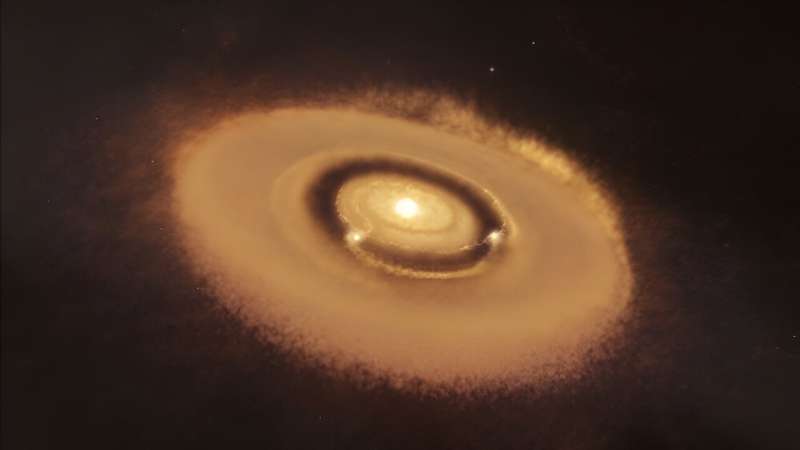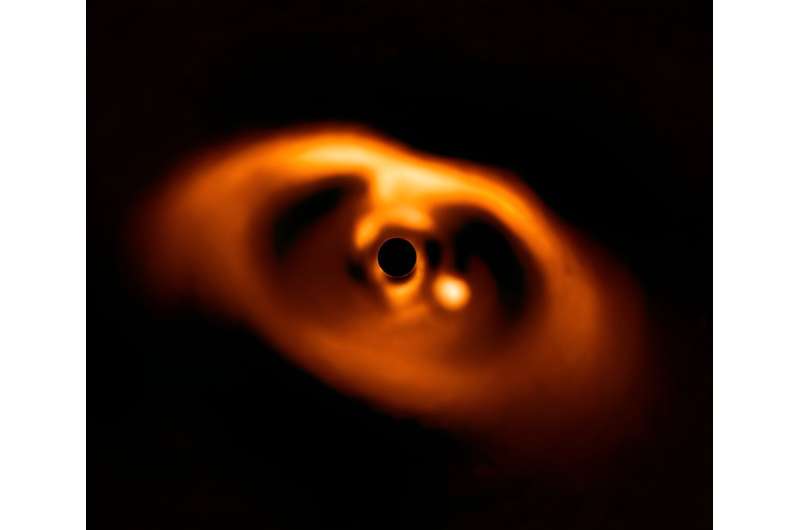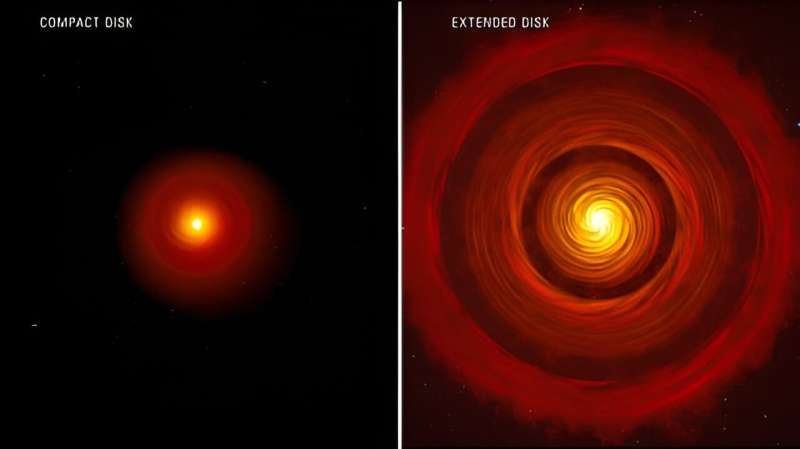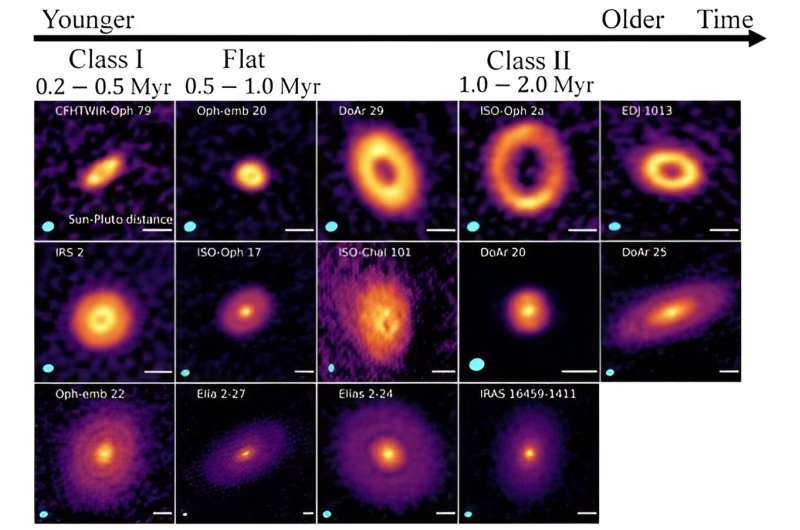This article has been reviewed according to Science X's editorial process and policies. Editors have highlighted the following attributes while ensuring the content's credibility:
fact-checked
trusted source
proofread
Webb finds hints of a third planet at PDS 70

The exoplanet census now stands at 5,599 confirmed discoveries in 4,163 star systems, with another 10,157 candidates awaiting confirmation. So far, the vast majority of these have been detected using indirect methods, including transit photometry (74.4%) and radial velocity measurements (19.4%).
Only 19 (or 1.2%) were detected via Direct Imaging, a method where light reflected from an exoplanet's atmosphere or surface is used to detect and characterize it. Thanks to the latest generation of high-contrast and high-angular resolution instruments, this is starting to change.
This includes the James Webb Space Telescope and its sophisticated mirrors and advanced infrared imaging suite. Using data obtained by Webb's Near-Infrared Camera (NIRCam), astronomers with the MIRI mid-INfrared Disk Survey (MINDS) survey recently studied a very young variable star (PDS 70) about 370 light-years away with two confirmed protoplanets.
After examining the system and its extended debris disk, they found evidence of a third possible protoplanet orbiting the star. These observations could help advance our understanding of planetary systems that are still in the process of formation.
The MINDS survey is an international collaboration consisting of astronomers and physicists from the Max-Planck-Institute for Astronomy (MPIA), the Kapteyn Astronomical Institute, the Space Research Institute at the Austrian Academy of Sciences (OAW-IFW), the Max-Planck Institute for Extraterrestrial Physics (MPE), the Centro de Astrobiología (CAB), the Institute Nazionale di Astrofisica (INAF), the Dublin Institute for Advanced Studies (DIAS), the SRON Netherlands Institute for Space Research, and multiple universities.
The paper describing their findings will appear in the journal Astronomy & Astrophysics and is currently available on the arXiv preprint server.
PDS 70 has been the subject of interest in recent years due to its young age (5.3 to 5.5 million years) and the surrounding protoplanetary disk. Between 2018 and 2021, two protoplanets planets were confirmed within the gaps of this disk based on direct imaging data acquired by sophisticated ground-based telescopes. This included the Spectro-Polarimetric High-contrast Exoplanet REsearch (SPHERE) and GRAVITY instruments on the ESO's Very Large Telescope (VLT) and the Atacama Large Millimeter/submillimeter Array (ALMA).

In recent years, the MINDS team has used Webb spectral data to perform chemical inventories on protoplanetary disks in multiple star systems. In a previous study based on data from Webb's Mid-Infrared Instrument (MIRI), the MINDS team detected water in the inner disk of PDS 70, located about 160 million km (100 million mi) or 1.069 AU from the star, a find that could have implications for astrobiology and the origins of water on rocky planets (like Earth). These results showcased Webb's impressive capabilities and how it can observe the cosmos in infrared (IR) wavelengths inaccessible to ground-based observatories.
Valentin Christiaens, an F.R.S-FNRS Postdoctoral Researcher at the University of Liège and KU Leuven, was the lead author of this latest paper. "The advantage of Webb's instruments is that they observe at infrared wavelengths that cannot be observed from the ground because of our atmosphere, which absorbs most of the infrared spectrum," he told Universe Today via email. "Thanks to Webb we can obtain measurements of planets in formation (called protoplanets) in infrared, which allow us to better constrain our models of planet formation."
For their latest study, the MINDS team examined PDS 70 using data from Webb's NIRCam as part of the MIRI Guaranteed Time Observations program on planet formation. Christiaens and his team were motivated to study PDS 70 further because previous research indicated the possible detection of a third protoplanet. This makes the system an ideal laboratory to study planet-disk interactions and search for accretion signatures. The presence of a possible third signal was detected in 2019 by a team using the VLT/SPHERE instrument but remained unconfirmed since.
One possible interpretation for this signal was that it traces a third planet. Using NIRCam data, Christiaens and his colleagues sought to redetect this signal and confirm that it was a third planet in the system. The JWST is especially well-suited to this task, thanks to its advanced optics and coronograph, which removes interference from Webb's images by blocking the star's light. He and his colleagues were also aided by advanced algorithms that help separate starlight from other point sources in orbit (like exoplanets) and debris disks. As Christiaens explained:

"The observation of another star, called a reference star, can be used to subtract the light from the star of interest and look for exoplanets there. In our study, we instead opted for a technique called 'roll subtraction,' where two sequences of images are taken of the star of interest before and after the instrument is rotated, respectively, so that the position of an exoplanet has rotated in the two image sequences. From there, by subtracting the images of one sequence from those of the other, and vice versa, we can effectively get rid of the light of the star and make images of its environment—planets and disk."
The team then combined their measurements with previous observations made with ground instruments and compared them to planetary formation models. From this, they could deduce the quantity of accumulated gas and dust around the protoplanet during the observation period. The quality of the images also allowed them to highlight a spiral arm of gas and dust supplying the second confirmed candidate (PDS 70 c), as predicted by the models. Lastly, they detected a bright signal consistent with a protoplanet candidate enshrouded in dust.
"What makes this candidate so interesting is that it could be in 1:2:4 resonance with planets b and c, already confirmed in the system (i.e., its orbital period will be almost exactly two times and four times shorter than that of b and c, respectively)," said Christiaens. This is precisely what happens with three of Jupiter's Galilean Moons (Ganymede, Europa, and Io), which are also in a 1:2:4 resonance. The possibility of a star system with three planets in this orbital relationship would be a gold mine for astronomers. "However, more observations are needed before this resonance can be confirmed," Christiaens added.
In addition to demonstrating Webb's capabilities, these findings could help inform our current understanding of how planetary systems form and evolve. This is one of the main objectives of the JWST: to use its advanced infrared optics to probe young star systems where planets are still in the process of forming. This has been a high priority for astronomers ever since Kepler began detecting exoplanets that defied widely accepted theories of how planetary systems form and evolve. In particular, the detection of many gas giants orbiting closely to their suns ("hot Jupiters") contradicted theories that gas giants form in the outer reaches of star systems.

By observing young star systems at different stages of formation, astronomers hope to test various theories about how the solar system came to be.
As Christiaens summarized, "The migration of planets is thought to play a crucial role in the evolution of planetary systems and helps explain the diversity of systems found to date via indirect methods. In many mature systems, planets have been found to resonate with each other, suggesting that this migration did indeed take place in the past. In our case, we observe a very young system, still in formation, where the two known giant planets seem to be in resonance and where the third potential planet, if confirmed, would also be with the other two. In the case of the solar system, we suspect that the migration and resonance capture of the giant planets probably also took place a very long time ago, [which could] explain their current configuration (Great Tack hypothesis). Here we are potentially observing it live in another system!"
More information: V. Christiaens et al, MINDS: JWST/NIRCam imaging of the protoplanetary disk PDS 70, arXiv (2024). DOI: 10.48550/arxiv.2403.04855
Provided by Universe Today




















